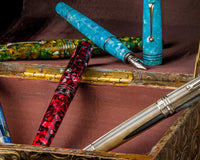Fountain pens are composed of many different parts, each one being just as important as the other. Without the nib, there would be no way of laying down the ink on paper. Take away the grip section and there would be nothing to hold onto while you write. And without a fountain pen ink filling system, there would be no way to put ink, the bloodline of a fountain pen, into your writing instrument.
Some filling systems are easier to use while others are better suited for different fountain pen users. There are dozens of ways to fill up a fountain pen, so discussing all of them in a single article wouldn’t be possible. The focus here will be on the most common ones seen and used today.
Here are a few examples of fountain pen filling systems:
Cartridge

One of the easiest and most convenient ways to fill a fountain pen with ink is with ink cartridges. In this case, plastic containers are pre-filled with ink, such as in the Platinum Plaisir fountain pen. Simply place it onto the section of your fountain pen where the back of the feed is and push down to pierce the cartridge open. This will allow the ink to flow into the feed and down to the nib using gravity.
This method is popular, especially among beginner fountain pen enthusiasts, because it is quick and easy, cost-efficient, and travel-friendly. The only two drawbacks are ink selection and capacity since cartridges are prefilled and quite small.
Converter

The converter is essentially a cartridge with a piston mechanism attached to it. This gives you the freedom to fill your pen with different bottled inks outside the disposable cartridge’s limitations. Although the ink capacity of a converter is small, it is also easier to clean.
Using a converter fountain pen like the Sailor Shikiori ProColor, start by removing the section of the pen so you can see the converter, which should be firmly inserted. Next, lower your nib into the bottle of ink you wish to use until it's breather hole is covered. Keeping the nib submerged, twist or pull the knob on the converter until it is filled with ink. Remove the pen from the bottle and pat the nib clean with a paper towel or a soft rag.
Piston

For those who prefer writing with a larger ink reservoir, fountain pens with piston filling systems may be the best option. These types of pens hold ink in the body itself, allowing you to write for longer periods. Like converters, you can use any ink you want with a piston filling system. However, these pens are also more expensive.
Most piston fountain pens like the TWSBI Eco Clear in Rose Gold come with a twist knob to draw ink up into the barrel. To fill your pen, start with the piston at the front of the pen (near the section or nib). Insert the nib into the ink bottle, making sure the breather hole is completely covered. Use the twist knob to activate the suction mechanism that pulls ink into the pen. Pat the nib dry once done.
Vacuum

A way to fill your pen with plenty of ink very quickly is through the vacuum filling system. This uses a plunger to create a vacuum, which is then broken so that the barrel of the fountain pen quickly fills with ink. What’s great about this filling system is that it is fully sealed, preventing any leakages.
To fill your pen, pull the plunger all the way up. Dip the nib into an ink bottle of your choice before pushing the plunger back into the pen to release the vacuum. Wipe the nib of excess ink before using it. Pens like the Pilot Custom 823 fountain pen are versatile and built to last, but that also means they are a bit more expensive. They may also be inconvenient for writers who are on the go since they can only be used with bottled ink.
Filling a fountain pen with ink can be extremely satisfying, sometimes even exciting! There’s nothing like the feeling of writing with a newly inked pen. Each filling system has its advantages and disadvantages, and what is best for you will ultimately depend on your needs and preference.
Happy filling and happy writing!
By Some Folks at EndlessPens







